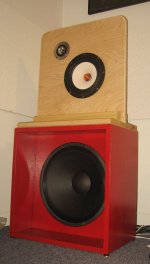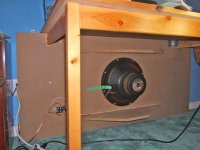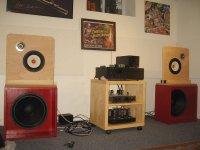Attachments
Wanna see a big sub OB?
Five feet wide. Sealed along the top to the table is it affixed to. 3/4 inch MDF. OB board spaced about 3 inches from all and attached to drywall in two places as well as firmly seated into the deep carpet. Stephens 150W, great 15 inch woofer of early 1960s. Cone resonance is 20 Hz.
Purpose was to address room modes by working mid-wall in parallel with Klipschorn in corner. Seems helpful in that goal.
DPDT phase reversal switch towards lower left corner. Not a lot of effect and not consistent across band. Surprised?
Very sweet bass... until the table and wall start shaking.
Five feet wide. Sealed along the top to the table is it affixed to. 3/4 inch MDF. OB board spaced about 3 inches from all and attached to drywall in two places as well as firmly seated into the deep carpet. Stephens 150W, great 15 inch woofer of early 1960s. Cone resonance is 20 Hz.
Purpose was to address room modes by working mid-wall in parallel with Klipschorn in corner. Seems helpful in that goal.
DPDT phase reversal switch towards lower left corner. Not a lot of effect and not consistent across band. Surprised?
Very sweet bass... until the table and wall start shaking.
Attachments
Last edited:
What did you use for the XO?
Jeff,
Good looking speaker and I bet it really sounds nice as well!
What are you using for the super tweeter?
Best Regards,
Terry
Jamo R907
Hi,
Those interested in Jamo open baffle speaker model: R907 can go to this site for a full review incl. Lab. measurements. It is valued at about AUD$17,000 retail.
http://igs.avhub.com.au/IgnitionSui..._Speakers_Review_LoRes.pdf?129349360484005890
Hi,
Those interested in Jamo open baffle speaker model: R907 can go to this site for a full review incl. Lab. measurements. It is valued at about AUD$17,000 retail.
http://igs.avhub.com.au/IgnitionSui..._Speakers_Review_LoRes.pdf?129349360484005890
...
Purpose was to address room modes by working mid-wall in parallel with Klipschorn in corner. Seems helpful in that goal.
Very interesting
Would you please share more about the whole setup? A picture of the whole system, for example?
Gainphile,
Have you tried using the Neo3 in any of your designs?
Very interesting
Would you please share more about the whole setup? A picture of the whole system, for example?
I appreciate your interest. But I think I can reply with words and from memory.
There is only one listening chair in my music room.
The room is roughly 10 x 15 feet (smallish, don't ask why... in a house with 13 other rooms). The one-meter-square Dayton-Wright ESL panels are across the narrow end and a few feet from the wall. Behind the right panel is the Klipschorn in the corner. Along the same wall, about mid-wall built into the bottom of a table, is the giant OB sub. Yes, the rear of the OB driver is about 4 feet from my right ear but I'm a big believer that a clean woofer is not localizable below 120 Hz.
The two woofers get the same signal (although from different amps - total of 6 amp-channels in my system), mixed bass below 110 Hz (24 dB/8ave), after passing through a parametric equalizer. I have two low freq bands to work with in the EQ. In the past I've tried to counter-act room modes with cuts and boosts - using glide tones (with cricket markers) as audible reference. That's a good use of EQ. At present, the EQ is just boosting bass (a few dB/8ave) to kind of compensate for the OB fall off.
I have a 25-year old pre-amp with a sophisticated bass-only "loudness" compensation. I've set my amps input volume controls way down so that the loudness compensation very nicely tracks the SPL. At loud levels ("6"), there's just a hint of boost. But at late-night low levels, quite a bit. GREAT benefit... that adaptable boost makes the bass just right at all levels. I am firm in my conviction that equal-loudness contours are an uncontestable reality and need to be addressed for music to sound right.
I've been doing a lot of mic testing and have learned very little that way except that room curves are really lousy and extremely variable depending on where you measure. Favourite way this month is low freq white noise signal viewed on a cumulative spectrum analyzer (free software) - quick, clear.
What I've done apropos room modes is straight out of the textbook (Toole) and works as good as expected. The more "divergent" the subs, the more benefit in molding the modes. Hard to think what could be more divergent than mixing a Klipschorn and a mid-wall giant OB. But I also got OK results with an AR-1W in about the same location although the K-horn and the AR have some similarities.
Hope that helps.
Last edited:
>>> XO...
>>> I bet it really sounds nice as well!
>>> What are you using for the super tweeter?
Thanks guys! This is the TangBand W8-1808 on open baffle without any circuit. The woofers are Alpha 15 in H-frames powered by the Dayton APA150 amp. That amp has a crossover control on the back. Any subwoofer plate amp will do as long as it has enough power. I think the Alpha 15 needs about 100 watts to 'wake up'... and the tweeter is something i had lying around about 10+ years, a Radio Shack 'pod' super tweeter. It sounded best to me using a cap value of .69uf. The whole thing sounds wonderful!
The 1808 is the most unusual driver in my collection so far. It appears to be mostly hand made using very delicate materials. The paper cone and wizzer are very thin and the surround is not the usual foam or rubber, more like a thin 'wet cloth'... it's all connected to a heavy magnet and frame that seems heavily built compared to the delicate cone/surround.
The sound is not quite neutral rather somewhat midrangy but in a mellow 'round' way. It's not as bright as the two Fostex drivers i have but i do like Fostex drivers too. It's light on its feet but does do bass. It's very detailed and relaxed. Listening fatigue is very low and i do listen a lot to this speaker for pleasure rather than messing around with crossovers all the time. I could live with this for a long while and am playing around with cheaper drivers now until i feel these overstay their welcome. They sound very pure with a bit of personality. If you like your vocals pushed slightly forward (as well as sax and trumpet) and your treble slightly recessed (but very clear) these are nice drivers. They also do that 'tone' thing where instruments have great decay and vibrato. For many this is what will make them worth the price. Piano sounds big and the notes ring out unlike most of the cheaper drivers i have. Guitars pop out sounding holographic on well recorded cds. I think they are pretty amazing actually and catch myself really enjoying music without thinking about changing things around. I think they would work well with just about any tweeter crossed over very high, above 15khz, and a large number of subwoofers crossed over below 100hz. They can also stand alone as a full range driver in a sealed or ported box without any help to be used in smaller rooms.
Sorry, i'm just trying to describe the drivers sound before someone makes a purchase. They are expensive but worth it imo.
>>> I bet it really sounds nice as well!
>>> What are you using for the super tweeter?
Thanks guys! This is the TangBand W8-1808 on open baffle without any circuit. The woofers are Alpha 15 in H-frames powered by the Dayton APA150 amp. That amp has a crossover control on the back. Any subwoofer plate amp will do as long as it has enough power. I think the Alpha 15 needs about 100 watts to 'wake up'... and the tweeter is something i had lying around about 10+ years, a Radio Shack 'pod' super tweeter. It sounded best to me using a cap value of .69uf. The whole thing sounds wonderful!
The 1808 is the most unusual driver in my collection so far. It appears to be mostly hand made using very delicate materials. The paper cone and wizzer are very thin and the surround is not the usual foam or rubber, more like a thin 'wet cloth'... it's all connected to a heavy magnet and frame that seems heavily built compared to the delicate cone/surround.
The sound is not quite neutral rather somewhat midrangy but in a mellow 'round' way. It's not as bright as the two Fostex drivers i have but i do like Fostex drivers too. It's light on its feet but does do bass. It's very detailed and relaxed. Listening fatigue is very low and i do listen a lot to this speaker for pleasure rather than messing around with crossovers all the time. I could live with this for a long while and am playing around with cheaper drivers now until i feel these overstay their welcome. They sound very pure with a bit of personality. If you like your vocals pushed slightly forward (as well as sax and trumpet) and your treble slightly recessed (but very clear) these are nice drivers. They also do that 'tone' thing where instruments have great decay and vibrato. For many this is what will make them worth the price. Piano sounds big and the notes ring out unlike most of the cheaper drivers i have. Guitars pop out sounding holographic on well recorded cds. I think they are pretty amazing actually and catch myself really enjoying music without thinking about changing things around. I think they would work well with just about any tweeter crossed over very high, above 15khz, and a large number of subwoofers crossed over below 100hz. They can also stand alone as a full range driver in a sealed or ported box without any help to be used in smaller rooms.
Sorry, i'm just trying to describe the drivers sound before someone makes a purchase. They are expensive but worth it imo.
Attachments
Hi,
From the back:
Looks like 12" 18sound.

By the way, I tried XD125 with dipole midrange / dipole bass and was not able to make it sound good together for my ears
- Elias
From the back:
Looks like 12" 18sound.
By the way, I tried XD125 with dipole midrange / dipole bass and was not able to make it sound good together for my ears
- Elias
Hi,
it takes some time to see all your great pictures! Thanks for it!
Thanks for it! 
http://analog-forum.de/wbboard/inde...pper&itemID=6213&type=page&from=user#imageTop
I show this open baffle in 2007, here: http://www.diyaudio.com/forums/full-range/103043-my-4x8-fullrange-open-baffle.html
Nice greatings, Hatti
it takes some time to see all your great pictures!
http://analog-forum.de/wbboard/inde...pper&itemID=6213&type=page&from=user#imageTop
I show this open baffle in 2007, here: http://www.diyaudio.com/forums/full-range/103043-my-4x8-fullrange-open-baffle.html
Nice greatings, Hatti
Last edited:
This is for the gallery. Divided Bass and Mid-Treble- Spruce Glue-lam baffles. Great effect.
Also Bass baflle picture, pianohinges and great movability.
Now Mid- and Treble has its own 20 x 60 cm baffle ancored by some 30 pound stone to prevent bass-influences to spread, it really works:
I did try some No Baffle solutions but in fact the small 8" (20 cm) baffle produced the very best results, no doubt.
So this is what it is like. Divided baffle between Bass (Eminence Alpha15s) and mid- tweet- 18Sound 6ND430 and B&G Radia Neo3W, all in dipole mode.
Crossover is with DCX2496 48 dB/octave at 250 Hz and 2 Khz, no other EQ applied.
So with this any OB is Challanged !
/Erling
An externally hosted image should be here but it was not working when we last tested it.
Also Bass baflle picture, pianohinges and great movability.
Now Mid- and Treble has its own 20 x 60 cm baffle ancored by some 30 pound stone to prevent bass-influences to spread, it really works:
An externally hosted image should be here but it was not working when we last tested it.
I did try some No Baffle solutions but in fact the small 8" (20 cm) baffle produced the very best results, no doubt.
An externally hosted image should be here but it was not working when we last tested it.
So this is what it is like. Divided baffle between Bass (Eminence Alpha15s) and mid- tweet- 18Sound 6ND430 and B&G Radia Neo3W, all in dipole mode.
Crossover is with DCX2496 48 dB/octave at 250 Hz and 2 Khz, no other EQ applied.
So with this any OB is Challanged !
/Erling
can you describe effect?Thank you
Yes they are cardboards and they work much better once my floor was carpetted.
and how you defined dimensions?
I have NO reflections from back wall
 , but side walls..
, but side walls.. and floor..
and floor..So with this any OB is Challanged !
Such a shame you live so far away...
This is for the gallery. Divided Bass and Mid-Treble- Spruce Glue-lam baffles. Great effect.
An externally hosted image should be here but it was not working when we last tested it.
Also Bass baflle picture, pianohinges and great movability.
Now Mid- and Treble has its own 20 x 60 cm baffle ancored by some 30 pound stone to prevent bass-influences to spread, it really works:
An externally hosted image should be here but it was not working when we last tested it.
I did try some No Baffle solutions but in fact the small 8" (20 cm) baffle produced the very best results, no doubt.
An externally hosted image should be here but it was not working when we last tested it.
So this is what it is like. Divided baffle between Bass (Eminence Alpha15s) and mid- tweet- 18Sound 6ND430 and B&G Radia Neo3W, all in dipole mode.
Crossover is with DCX2496 48 dB/octave at 250 Hz and 2 Khz, no other EQ applied.
So with this any OB is Challanged !
/Erling
Very nice
Why not go even further and try to xover low/mid as low as possible...? I'm guessing that even 100hz is possible with EQ. This would eliminate the biggest flaw of high qts woofers: low resolution in low mids (100hz and up)
VK-1 Dipole Loudspeakers
http://hephaestusaudio.com/media/2008/11/vk-1-dipole-loudspeaker.pdf
This is the first speaker system that I have heard that does not get loud when you turn it up – it simply gets bigger. The impression is similar to hearing an acoustic instrument in close proximity: the level of the sound can be quite high; however, it tends to fill the space rather than simply being loud. Also, the listening space I have the drivers in is not especially large, however it sounds quite large with these speakers. Dipoles really do have a way of presenting a big image.
Aurum Cantus G2Si aluminum ribbon tweeter
Eminence Lil’ Buddy 10” hemp cone driver
Eminence Sigma Pro-18A 18” paper cone driver

The bass response was the biggest surprise. I had elected to use an 18” woofer because I was certain I would need this size to get adequate bass from a modest size baffle without any sort of “wings”. Well, I was wrong. I believe I could have used a comparable 12” woofer and had plenty of bass for my tastes. The gentle 6dB/oct rolloff of a dipole seems to really help with low-frequency extension.

I dared on one occasion to serenade the neighborhood with Tchaikovsky’s 1812 Festival Overture. It was worth it. The bass from Kraftwerk’s Aero Dynamik is something to hear and goes way, way down. The “Pilgrim’s Chorus” from the Solti recording of Wagner’s Tannhauser does not sound like a jumbled mess of voices – it manages to remain distinct and, again, very big. There is Berlioz’s La Marseillaise too, oh and Faure’s Pavane…okay, I need to stop typing and go listen! How about a little of the Rod Blumenau Trio?
http://hephaestusaudio.com/media/2008/11/vk-1-dipole-loudspeaker.pdf
This is the first speaker system that I have heard that does not get loud when you turn it up – it simply gets bigger. The impression is similar to hearing an acoustic instrument in close proximity: the level of the sound can be quite high; however, it tends to fill the space rather than simply being loud. Also, the listening space I have the drivers in is not especially large, however it sounds quite large with these speakers. Dipoles really do have a way of presenting a big image.
Aurum Cantus G2Si aluminum ribbon tweeter
Eminence Lil’ Buddy 10” hemp cone driver
Eminence Sigma Pro-18A 18” paper cone driver

The bass response was the biggest surprise. I had elected to use an 18” woofer because I was certain I would need this size to get adequate bass from a modest size baffle without any sort of “wings”. Well, I was wrong. I believe I could have used a comparable 12” woofer and had plenty of bass for my tastes. The gentle 6dB/oct rolloff of a dipole seems to really help with low-frequency extension.

I dared on one occasion to serenade the neighborhood with Tchaikovsky’s 1812 Festival Overture. It was worth it. The bass from Kraftwerk’s Aero Dynamik is something to hear and goes way, way down. The “Pilgrim’s Chorus” from the Solti recording of Wagner’s Tannhauser does not sound like a jumbled mess of voices – it manages to remain distinct and, again, very big. There is Berlioz’s La Marseillaise too, oh and Faure’s Pavane…okay, I need to stop typing and go listen! How about a little of the Rod Blumenau Trio?
- Home
- Loudspeakers
- Multi-Way
- Ultimate Open Baffle Gallery





